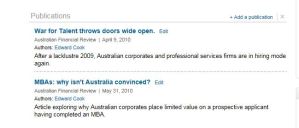Over the next few weeks I’ll be writing a blog on using Social Media and specifically Linkedin to engage with potential, passive Talent. I’m going to write it from the perspective of providing a guide for corporate hiring managers. The first post is an introduction and some tips on creating an engaging Linkedin profile.
Introduction.
If you’re sceptical about the power or relevance of social media, before reading the rest of this please watch the following video. [YouTube video – http://youtu.be/x0EnhXn5boM]
There are currently 2 million Australians using Linkedin (2011). Corporates are increasingly weaving it into their recruitment strategy as a cost effective way to engage with the passive market. Building Talent communities is all the rage and these companies aim to build authentic relationship with potential employees.
In the past the most valuable asset an Agency based recruitment consultant had was their Agencies’ database. This is no longer the case; Linkedin is a database that anyone can access, with user-updated, relevant information. As a result agency recruiters are struggling to evolve their business model to one that justifies the high fees they charge clients. In my opinion, there are only two recruitment models that will survive: 1. The volume recruiters that run assessment centres for their clients and 2. Executive Search Consultants that extensively map a market and have the skill to engage with passive talent. The traditional, transactional recruiters will no longer be able to justify the high cost and low value add of their service. So, what’s the alternative? Hiring Managers can use Linkedin to firstly build a relevant network and then actively engage with that network, alerting relevant connections when they are looking to attract talent into their team. The aim of this guide is to provide information to enable a hiring Manager to do this effectively.
Your Linkedin profile reflects your online brand.
What does your Linkedin profile say about you? Would someone looking to work at Dimension Data know what you do by looking at your profile? Does it portray you as a specialist within your field?
If you Google your name you are more than likely to find yourself appearing somewhere on the internet. Before meeting with you, people are more and more likely to Google your name; the Google search algorithms place more importance on Linkedin information than on most other sources. This gives you the ability to manage your online brand, by creating a Linkedin profile with relevant, accurate information. As we build Dimension Data’s brand awareness in the market potential recruits will be searching Linkedin, looking for relevant hiring managers to approach, a prominent Linkedin profile will enable you to establish yourself as a Dimension Data ambassador.
So, what does a good Linkedin profile look like? I’ll run through the various parts of a profile and suggest some ways to maximise its overall effectiveness.
Who should I connect with?
I personally connect with anyone I meet with in a business setting, this would include: networking breakfasts, suppliers, clients, past colleagues current colleagues. I also receive quite a few invitations, I generally split these into three groups: People I have met with in the past – I accept these. People who share a common focus (same industry etc) – I accept these and may reply to arrange to catch up face to face and thirdly people I’ve never met and do not have any similarities in terms of focus – I generally reject these.
The main benefits of having an extensive, relevant network is that when you carry out an advanced search or share an opportunity to share you will have access to a substantial group of relevant people.
Summary and Specialties.
The summary gives you the opportunity to concisely communicate your strengths and areas of expertise. As I’m looking at this from the perspective of a hiring manager, someone wh o reads your summary should be thinking “I’d love to report to this person and I’ve got a good idea of what they do.” Have a look at other Linkedin profiles to get an idea of what to write in your own. The Specialties section is somewhere to dump keywords that describe all your skills; these keywords will enable prospective candidates to find you when they conduct an “Advanced search”, more on this later.
o reads your summary should be thinking “I’d love to report to this person and I’ve got a good idea of what they do.” Have a look at other Linkedin profiles to get an idea of what to write in your own. The Specialties section is somewhere to dump keywords that describe all your skills; these keywords will enable prospective candidates to find you when they conduct an “Advanced search”, more on this later.
Publications and Applications sections.
Do you write a blog or have you presented on a specific topic as part of your job? These sections provide
you with the ability to showcase your knowledge; once again, someone that views your profile should gain an insight into your interests, knowledge and ability. Having read your opinions here, hopefully you’ve piqued their interest and they want to meet you to find out more.
Experience
Taking the time to complete your experience again provides people with the opportunity to find out more about you in order to make an informed decision whether to approach you. Also, when you do meet someone they will be knowledgeable about your background so you can have a concise, relevant conversation.
Next week I’ll explore using Advanced search to identify passive candidates and also look at ways to approach them.

